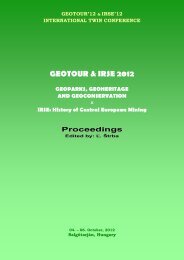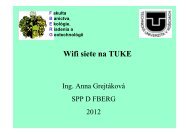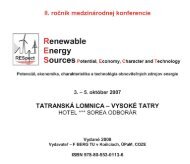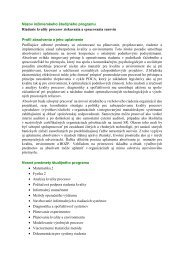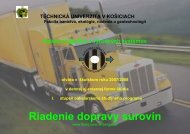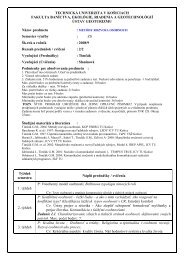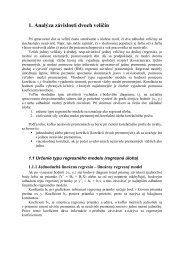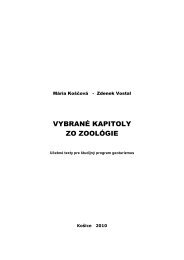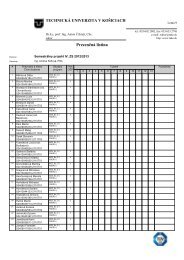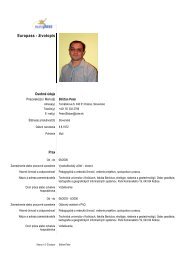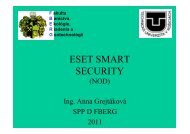GEOTOUR & IRSE 2012.pdf - Fakulta BERG - TUKE
GEOTOUR & IRSE 2012.pdf - Fakulta BERG - TUKE
GEOTOUR & IRSE 2012.pdf - Fakulta BERG - TUKE
Create successful ePaper yourself
Turn your PDF publications into a flip-book with our unique Google optimized e-Paper software.
Salgótarján, 04. – 06. 2012<br />
in Lower Silesia, as well as those of smaller importance but having a documented multicentury<br />
history of exploration and exploitation. Among the regions under the study are: the<br />
site of former copper and arsenic ore mining in the vicinity of Miedzianka, Ciechanowice and<br />
Janowice Wielkie, polymetallic ores in Radzimowice and Czarnów, tin and cobalt ores in<br />
Gierczyn and Przecznica, chromite in the Ślęża Massif, iron and uranium in the region of<br />
Kowary, iron in Stanisławów, lead and silver in the neighbourhood Marcinków, Bystrzyca<br />
Górnej and Modliszów.<br />
It is worth noting that the scale of problems connected with researching former mining sites is<br />
difficult to comprehend for people not engaged in that issue. Practically, at almost each centre<br />
of former exploitation the mining works were carried on periodically within the space of<br />
several hundred years. With the development of knowledge and technique, the previously<br />
abandoned workings were revisited several times and the depth of exploitation was<br />
continually increased with the aim to make use of the newest achievements in mining<br />
technology and geological knowledge. The effect of such type of activities is a large number<br />
of former mine workings and surface building remains, often spread even within a single<br />
centre of former mining works over a large, usually undulating area, The footprints of former<br />
works are usually obliterated as a result of different kind of works carried on after abandoning<br />
the mining works, e.g. forestry works. The precise study of a single site, even without giving<br />
consideration to underground workings is a long-term and arduous work requiring the<br />
participation of a team of experts, including mining archaeologists. The identification and<br />
examination of underground workings entail speleological works, and the access to the<br />
interiors of former mines often requires reopening of their outlets that had been filled up for<br />
hundreds of years. This type of activity involves, which is obvious, the necessity to make<br />
many formal and legal arrangements, to say nothing about the considerable costs of its<br />
completion. Due to the above reasons, most of the hitherto completed research and<br />
cataloguing work has been limited to the superficial identification of former mining work sites<br />
and still accessible parts of workings. Thanks to the cooperation with the archaeologists from<br />
the Wrocław University and the Museum of Copper in Legnica, information on the forgotten<br />
former work remains of historical value are passed to the competent Heritage Conservator and<br />
as a result of these activities they will become protected by law.<br />
Due to the importance of the historical mining centres, the scope and results of completed<br />
research (and revitalisation) work, and what is particularly important – the possibilities of<br />
using them in industrial tourism and geo-tourism, the results of the work carried out in the<br />
operating area of former lead and silver ore mines in Bystrzyca Górna (the Sowie Mountains,<br />
in the neighbourhood of Świdnica) and those conducted in the historical region of tin and<br />
cobalt ore mining in Gierczym and Przecznica (in the neighbourhood of Świeradów) are<br />
presented below.<br />
FORMER LEAD AND SILVER ORE MINING SITES IN BYSTRZYCA GÓRNA (SOWIE MOUNTAINS,<br />
IN NEIGHBOURHOOD OF ŚWIDNICA)<br />
The area of the occurrence of quarts-barite veins with polymetallic mineralisation (mainly in<br />
the form of lead and silver minerals) in the neighbourhood of Bystrzyca Górna in the Sowie<br />
Mountains was, within the space of more than five centuries, subjected periodically to fairly<br />
intense exploration and exploitation works [9]. Within the distance of about 500 m from the<br />
local buildings, in the area formerly known as “Goldener Wald” (Golden Forest), and more<br />
precisely, in the area known as “Silber Wiese” (Silver Meadow) the following mines operated<br />
in a chronological order: Segen Gottes, Christinenglück, Victor Friedrich, Wilhelmine, Beathe<br />
and probably Berthe. It should be assumed that, in that site, the mining works were carried on<br />
by the oldest Bystrzyca miners‟ guilds St. Stefens Achter and Geistliche Hülf Gottes.<br />
Although the documented information on the mining works in the neighbourhood of<br />
Bystrzyca Górna concerns only the year of 1539 [4] it is no way not to rule out the<br />
106



